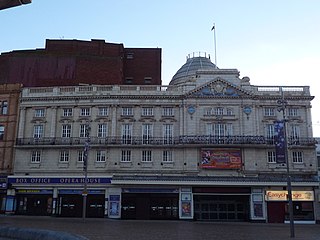
Buxton is a spa town in the Borough of High Peak, Derbyshire, England. It is England's highest market town, sited at some 1,000 feet (300 m) above sea level. It lies close to Cheshire to the west and Staffordshire to the south, on the edge of the Peak District National Park. In 1974, the municipal borough merged with other nearby boroughs, including Glossop, to form the local government district and borough of High Peak.

The Royal Opera House (ROH) is an opera house and major performing arts venue in Covent Garden, central London. The large building is often referred to as simply Covent Garden, after a previous use of the site. It is the home of The Royal Opera, The Royal Ballet, and the Orchestra of the Royal Opera House. The first theatre on the site, the Theatre Royal (1732), served primarily as a playhouse for the first hundred years of its history. In 1734, the first ballet was presented. A year later, the first season of operas, by George Frideric Handel, began. Many of his operas and oratorios were specifically written for Covent Garden and had their premieres there.
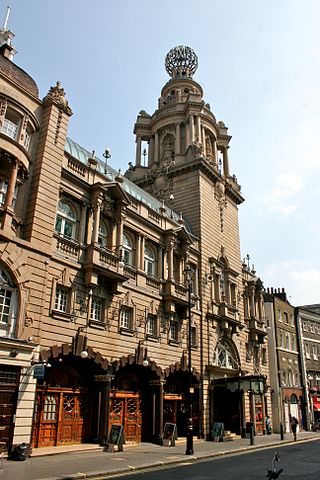
The London Coliseum is a theatre in St Martin's Lane, Westminster, built as one of London's largest and most luxurious "family" variety theatres. Opened on 24 December 1904 as the London Coliseum Theatre of Varieties, it was designed by the architect Frank Matcham for the impresario Oswald Stoll. Their ambition was to build the largest and finest music hall, described as the "people's palace of entertainment" of its age.

The Theatre Royal is a historic theatre, a Grade I listed building situated on Grey Street in Newcastle upon Tyne.

The Palace Theatre, Manchester, is one of the main theatres in Manchester, England. It is situated on Oxford Street, on the north-east corner of the intersection with Whitworth Street. The Palace and its sister theatre the Opera House on Quay Street are operated by the same parent company, Ambassador Theatre Group. The original capacity of 3,675 has been reduced to its current 1,955.

The International Gilbert and Sullivan Festival was founded in 1994 by Ian Smith and his son Neil and is held every summer in England. The two- or three-week Festival of Gilbert and Sullivan opera performances and fringe events attracts thousands of visitors, including performers, supporters, and G&S enthusiasts from around the world. The Festival was held in Buxton, Derbyshire, from 1994 to 2013, and from 2014 to 2022, it was held in Harrogate, North Yorkshire, usually with a week in Buxton preceding the main part of the Festival. The entire Festival is set to return to Buxton in 2023.

The Bristol Hippodrome is a theatre located in The Centre, Bristol, England, United Kingdom with seating on three levels giving a capacity of 1,951. It frequently features shows from London's West End when they tour the UK, as well as regular visits by Welsh National Opera and an annual pantomime.

Amateur theatre, also known as amateur dramatics, is theatre performed by amateur actors and singers. Amateur theatre groups may stage plays, revues, musicals, light opera, pantomime or variety shows, and do so for the social activity as well as for aesthetic values. Productions may take place in venues ranging from the open air, community centres, or schools to independent or major professional theatres.
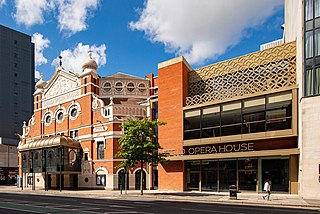
The Grand Opera House is a theatre in Belfast, Northern Ireland, designed by the most prolific theatre architect of the period, Frank Matcham. It opened on 23 December 1895. According to the Theatres Trust, the "magnificent auditorium is probably the best surviving example in the United Kingdom of the oriental style applied to theatre architecture". The auditorium was restored to its former glory, and the foyer spaces and bars were reimagined and developed as part of a £12.2 million project in 2020/2021, generously supported by the National Lottery Heritage Fund. [1]
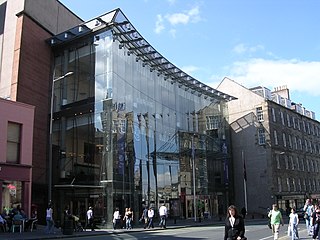
The Edinburgh Festival Theatre is a performing arts venue located on Nicolson Street in Edinburgh, Scotland. It is used primarily for performances of opera and ballet, large-scale musical events, and touring groups. After its most recent renovation in 1994, it seats 1,915. It is one of the major venues of the annual summer Edinburgh International Festival and is the Edinburgh venue for the Scottish Opera and the Scottish Ballet.
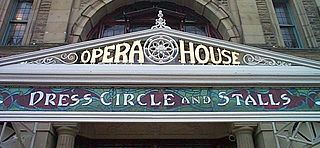
The Buxton Festival is an annual summer festival of opera, music and a literary series, held in Buxton, Derbyshire, England since its beginnings in July 1979. The 2020 festival would have run but was cancelled due to the Covid-19 crisis. The 2023 Buxton International Festival will run 6–23 July.
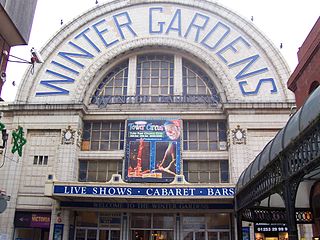
The Winter Gardens is a large entertainment complex in Blackpool, Lancashire, England, which includes a theatre, ballroom and conference facilities. Opened in 1878, it is a Grade II* listed building, operated by Blackpool Entertainment Company Limited on behalf of Blackpool Council, which purchased the property from Leisure Parcs Ltd as part of a £40 million deal in 2010.

Opera della Luna (OdL), founded in 1994, is a British touring theatre troupe of actor-singers focusing on comic works. Led by artistic director Jeff Clarke, it takes its name from Haydn's operatic setting of Goldoni's farce Il mondo della luna. The company presents innovative, usually zany and irreverent, small-scale productions and adaptations of Gilbert and Sullivan, Offenbach and other comic opera and operetta, in English. OdL is a registered British charity.

The Southport Winter Gardens was a Victorian entertainment complex in the town of Southport, Merseyside. The original winter gardens comprised a theatre, opera house, aquarium, a small zoo, conservatory, promenades and halls situated under the grand glass domes.

The Royal Hall is a Grade II* listed performance hall and theatre, located in Harrogate, North Yorkshire, England.

The National Gilbert & Sullivan Opera Company is an English professional repertory company that performs Gilbert and Sullivan's Savoy operas. Founded in 1995 to perform at the International Gilbert and Sullivan Festival, the company generally stages three or four productions each summer, giving up to 16 performances in Harrogate, North Yorkshire, and also touring.
The Theatre Royal, Hanley was a theatre in Stoke-on-Trent, England with a long history.
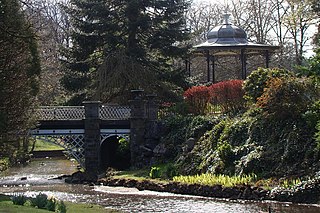
Buxton Pavilion Gardens is a Victorian landscaped public park in the spa town of Buxton in Derbyshire. The River Wye flows through the gardens, which are a Grade II* listed public park of Special Historic Interest.

The Pavilion Arts Centre was opened in 1889 as the new Entertainment Stage theatre on St John's Road in Buxton, Derbyshire, England. It is part of the Pavilion Gardens complex of buildings in the town's central Conservation Area. It has a main 360-seat theatre, and since 2017 it has been the home of Buxton Cinema.



















